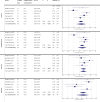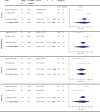The relationship between bi-spectral index and VOTE score in evaluation of drug-induced sleep endoscopy: A systematic meta-analysis
- PMID: 37747022
- PMCID: PMC10519450
- DOI: 10.1097/MD.0000000000035209
The relationship between bi-spectral index and VOTE score in evaluation of drug-induced sleep endoscopy: A systematic meta-analysis
Abstract
Objective: The aim of this study was to investigate both the presence and severity of collapse in anatomical regions defined by the VOTE score (velum, orofarinx, tongue, and epiglottis), during drug induced sleep endoscopy (DISE) in patients diagnosed with obstructive sleep apnea, based on the bi-spectral index (BIS) sedation level.
Methods: In order to conduct a meta-analysis of articles examining the relationship between the VOTE score and BIS sedation level in determining the presence and severity of upper airway collapse during DISE, a literature review was performed.
Results: As a result of the search made in the specified databases, a total of 1864 articles were reached. Five articles included in this review that had sufficient statistical data to be included in the meta-analysis were found. A statistically significant correlation was found between the BIS sedation level and the areas of obstruction in the VOTE score. The strongest association is at the epiglottis level, followed by the velum, oropharynx, and tongue, respectively (CC: 0.639, CC: 0.53, CC: 0.49, and CC: 0.346, P < .001). In the subgroup analysis of publications with BIS sedation levels in the range of 60 to 65, the distribution in the epiglottis region was heterogeneous, and it was found to be statistically significant according to the random effect model (P < .001). The distribution in the tongue was homogeneous, and it was found to be statistically significant according to the fixed effect model (P < .001). When the publications in which the BIS sedation level is in the range of 65 to 75 are examined according to the areas of obstruction; the distribution in 4 anatomical regions was homogeneous and statistically significant according to the fixed effect model (P < .001).
Conclusion: It was found that BIS sedation levels during DISE application in obstructive sleep apnea patients were associated with obstruction of the anatomical regions of the upper airway. The strongest association was found at the epiglottis level, followed by the velum, oropharynx, and tongue, respectively. It is helpful to monitor the sedation level with BIS in order to better define the collapsed areas during DISE application. However, more studies are needed to better understand the relationship between BIS sedation values and sleep stages.
Copyright © 2023 the Author(s). Published by Wolters Kluwer Health, Inc.
Conflict of interest statement
The authors have no funding and conflicts of interest to disclose.
Figures




References
-
- Borowiecki B, Pollak CP, Weitzman ED, et al. . Fibro-optic study of pharyngeal airway during sleep in patients with hypersomnia obstructive sleep-apnea syndrome. Laryngoscope. 1978;88(8 Pt 1):1310–3. - PubMed
-
- Ravesloot MJ, de Vries N, Stuck BA. Treatment adherence should be taken into account when reporting treatment outcomes in obstructive sleep apnea. Laryngoscope. 2014;124:344–5. - PubMed
-
- Stuck BA, Leitzbach S, Maurer JT. Effects of continuous positive airway pressure on apnea-hypopnea index in obstructive sleep apnea based on long-term compliance. Sleep Breath. 2012;16:467–71. - PubMed
-
- Ghorbani J, Adimi Naghan P, Safavi Naeini A, et al. . Can be compared obstructive respiratory events during drug induced sleep endoscopy (DISE) and nocturnal polysomnography. Eur Arch Otorhinolaryngol. 2020;277:1379–84. - PubMed
Publication types
MeSH terms
LinkOut - more resources
Full Text Sources
Research Materials
Miscellaneous

